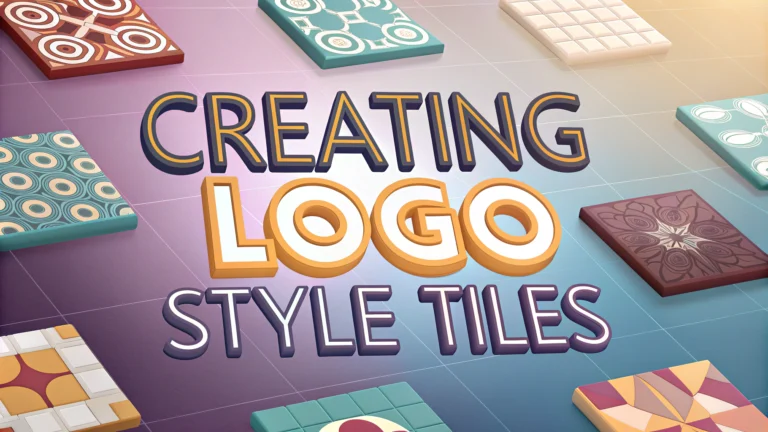Logo style tiles serve as essential design tools that help create consistent and professional brand identities.
Style tiles bring together key visual elements like colors, typography, patterns, and graphic elements that define a logo’s aesthetic direction.
Key Components of Logo Style Tiles
- Color palette with primary and secondary brand colors
- Typography selections and font hierarchy
- Logo variations and lockups
- Design elements and patterns
- Image treatment guidelines
Creating Effective Style Tiles
Start by collecting inspiration and reference materials that align with the brand’s personality and goals.
Define 3-5 core brand colors, including specific hex codes and RGB/CMYK values for consistent reproduction.
Select 2-3 complementary fonts that work well together – typically one for headlines and another for body text.
Logo Variations to Include:
- Primary logo design
- Secondary/alternate versions
- Monochrome options
- Minimum size requirements
- Clear space specifications
Practical Applications
Style tiles help maintain brand consistency across different platforms and materials.
Share style tiles with team members, clients, and vendors to ensure everyone follows the same design standards.
Use style tile specifications as a reference when creating new marketing materials or brand assets.
Tools for Creating Style Tiles
- Adobe Creative Suite – Industry standard for professional design work
- Figma – Collaborative design tool perfect for sharing style guides
- Sketch – Popular among Mac users for interface and logo design
- Canva – User-friendly option for beginners
Best Practices
- Keep the layout clean and organized
- Include examples of correct and incorrect usage
- Document specific measurements and spacing guidelines
- Add explanatory notes for complex specifications
- Update style tiles as brand elements evolve
Save style tiles in multiple formats (PDF, AI, PNG) for easy sharing and reference.
Store style tiles in a central location accessible to all team members who need them.
Review and update style tiles periodically to ensure they remain current with brand evolution.
Implementation Guidelines
Style tiles should be accompanied by clear implementation guidelines to ensure proper usage across all brand touchpoints.
Digital Implementation:
- Website header and footer usage
- Social media profile requirements
- Email signature formats
- Digital advertising specifications
Print Implementation:
- Business card and letterhead placement
- Marketing collateral standards
- Signage requirements
- Packaging guidelines
Quality Control
Regular audits help maintain brand consistency and identify areas requiring updates or clarification.
- Conduct quarterly brand consistency reviews
- Document any deviations from style guidelines
- Address common implementation challenges
- Provide additional training when needed
Conclusion
Logo style tiles are fundamental tools for maintaining brand integrity and ensuring consistent visual communication across all platforms.
Success depends on clear documentation, accessible resources, and regular updates to meet evolving brand needs.
When properly implemented, style tiles create a strong foundation for professional and cohesive brand presentation.
FAQs
- What is a logo style tile and why is it important in the design process?
A logo style tile is a visual document that presents different design variations, color schemes, typography choices, and potential applications of a logo. It’s crucial for establishing brand consistency and getting client approval before finalizing a logo design. - What elements should be included in a logo style tile?
Logo style tiles should include the main logo variations (primary, secondary, monochrome), color palette with hex codes, typography selections, minimum size requirements, clear space rules, and examples of logo usage on different backgrounds. - How many logo variations should be presented in a style tile?
Typically, 2-3 distinct logo concepts should be presented, each with horizontal and vertical orientations, monochrome versions, and reverse (white) versions for dark backgrounds. - What file formats should be included with logo style tiles?
Logo style tiles should include vector formats (AI, EPS, SVG) for scalability, and raster formats (PNG, JPG) for digital use. Each format should be provided for all approved logo variations. - How should colors be presented in a logo style tile?
Colors should be presented with their exact specifications in multiple color systems: RGB values for digital use, CMYK for printing, Pantone codes for specialty printing, and hexadecimal codes for web use. - What typography information needs to be included in a logo style tile?
Typography specifications should include primary and secondary fonts, font weights, spacing guidelines, and alternative fonts for when primary choices aren’t available. - How do you demonstrate logo scalability in a style tile?
Include examples of the logo at different sizes, from very large to very small, with clear minimum size requirements to maintain legibility across all applications. - What are the essential spacing rules to include in a logo style tile?
Clear space rules should be defined using a measurable unit (often based on a logo element) to show minimum spacing requirements around the logo to maintain visual impact. - How should logo misuse be addressed in style tiles?
Include examples of incorrect logo usage, such as stretching, color alterations, rotation, or inappropriate backgrounds, to prevent brand misrepresentation. - What contextual applications should be shown in logo style tiles?
Show the logo in real-world applications such as business cards, signage, social media profiles, and various marketing materials to demonstrate versatility and practical usage.








